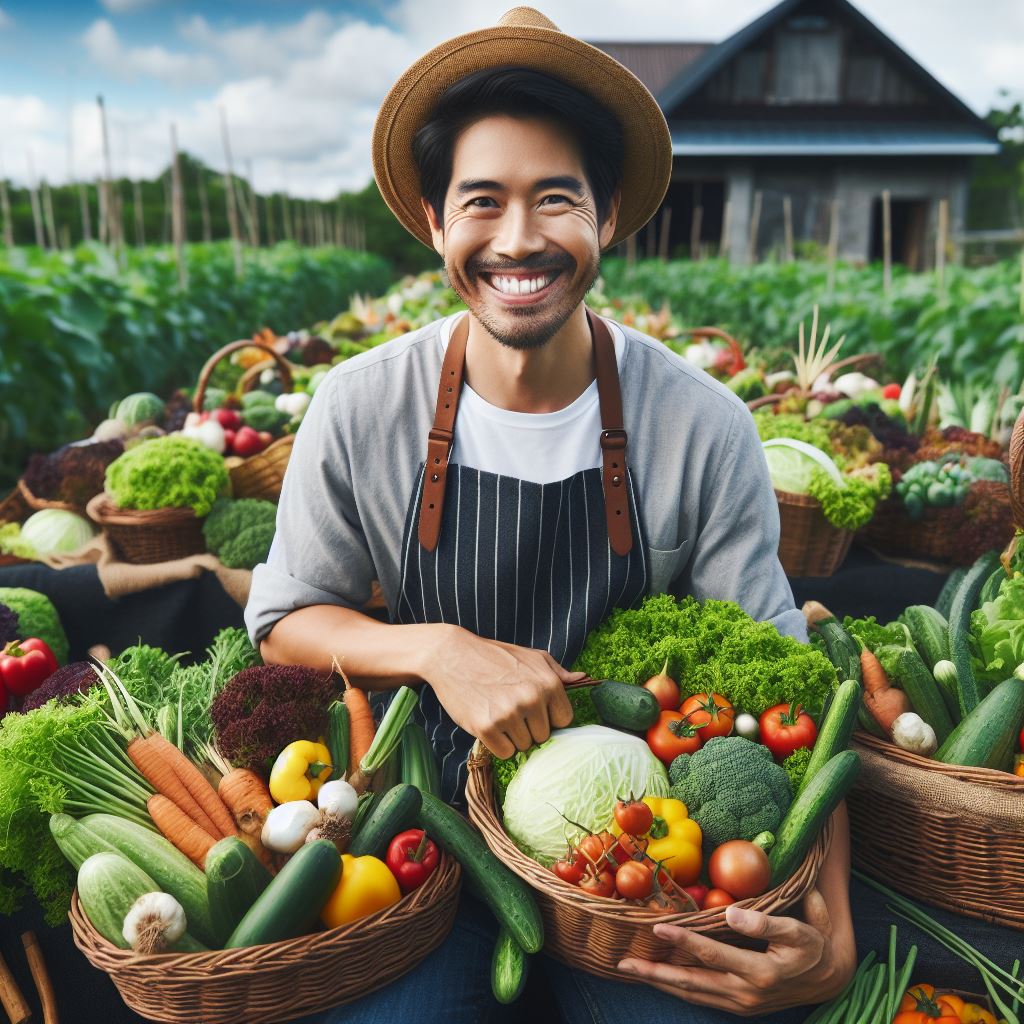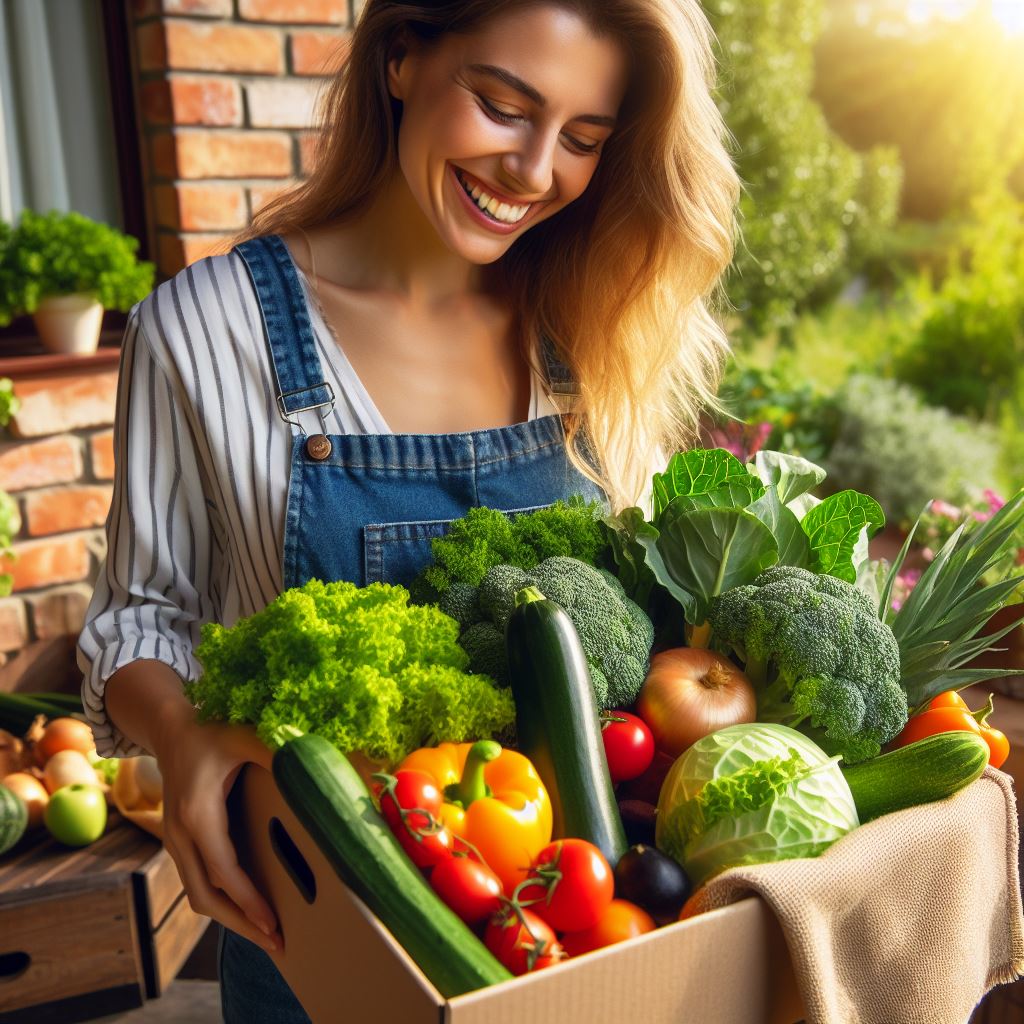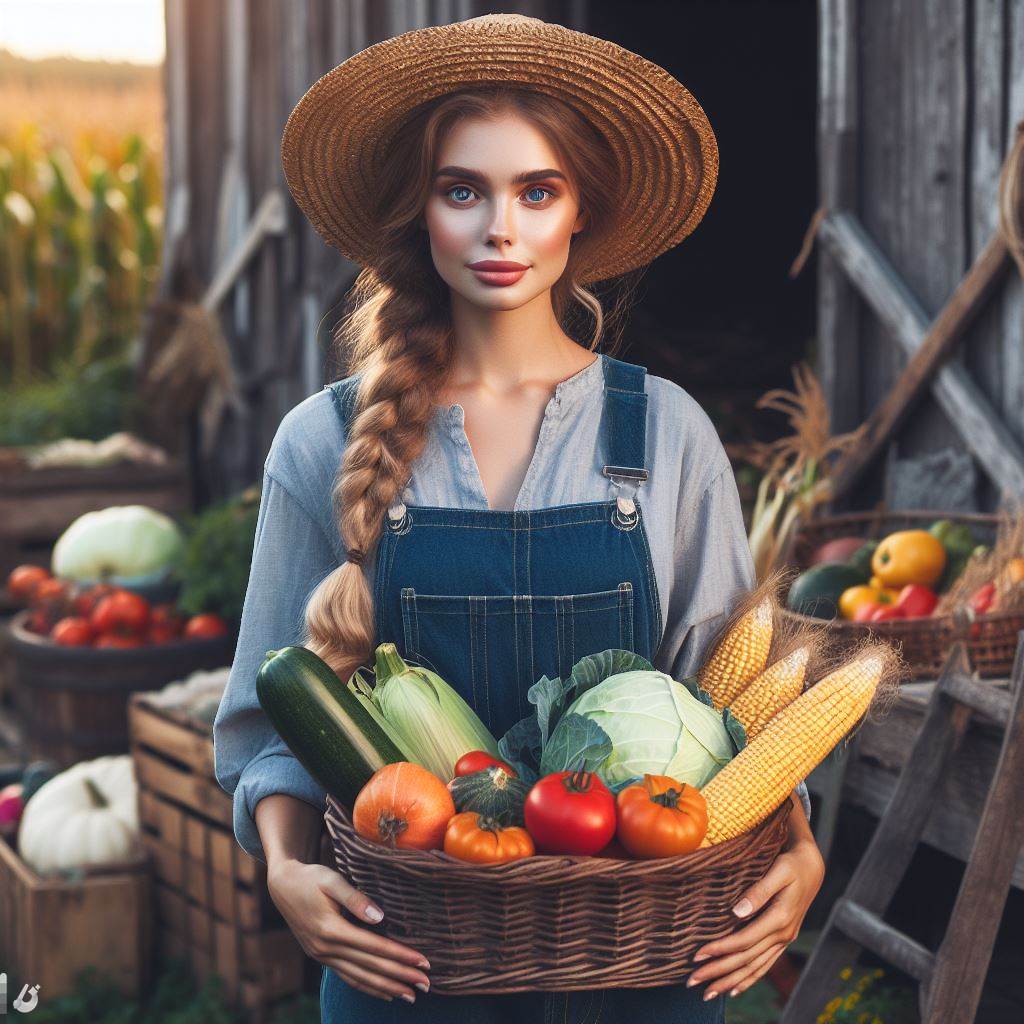Introduction
Farmers and gardeners pass down unique heirloom vegetables through generations, valuing their exceptional flavors, colors, and textures.
Unlike conventional produce, heirlooms are preserved for distinctive tasting profiles, captivating palates and imaginations.
The rough-skinned Brandywine tomato, tracing back over 100 years, exemplifies this tradition. Many more recent varieties also boast equal complexity.
Recently, heirlooms have grown increasingly popular with home cooks and restaurants seeking new flavors and sustainable ingredients.
From fiery Cherokee Purple tomatoes to honey-sweet watermelons and wildly fractal Romanesco broccoli, these botanical artifacts offer novel sensory adventures and hands-on history lessons with every serving.
As we rediscover near-forgotten plant diversity on our plates, heirloom vegetables present novel ways of reconnecting with localized tastes and agriculture traditions of the past.
The History of Heirloom Veggies
Definition of heirloom veggies
Heirloom veggies refer to plant varieties that have been passed down through generations, often for over 50 years.
Origins of heirloom veggies
These vegetables originate from seeds that have been carefully saved and cultivated by farmers and gardeners.
- Native varieties: Many heirloom veggies come from native plants that have been traditionally grown by indigenous communities.
- Old world varieties: Some heirloom veggies were brought to the Americas by European immigrants, who valued their unique flavors.
Importance of preserving heirloom varieties
Preserving heirloom veggies is vital for several reasons, including biodiversity, flavor diversity, and cultural heritage.
- Biodiversity: Heirloom veggies contribute to biodiversity by providing a wide range of genetic variations within a single plant species.
- Flavor diversity: Heirloom veggies offer a vast array of flavors, textures, and colors that are often lost in modern commercial varieties.
- Cultural heritage: Growing and consuming heirloom veggies connects us to our culinary history and the traditions of our ancestors.
- Resilience: Heirloom varieties have adapted over time to specific growing conditions, making them more resilient to pests and diseases.
- Seed sovereignty: Preserving heirloom veggies allows farmers and gardeners to maintain control over their seeds and ensure food security.
Examples of heirloom veggies and their stories
- Mortgage Lifter Tomato: Developed in the 1930s, this tomato variety gained popularity when a farmer used its sales to pay off his mortgage.
- Moon and Stars Watermelon: Named for its dark green skin with yellow spots resembling stars, this watermelon dates back to the early 1900s.
- Glass Gem Corn: Known for its vibrant rainbow-colored kernels, this corn variety was rediscovered in the 1970s after nearly disappearing.
- Black Krim Tomato: Originating from Crimea, this tomato offers a rich, smoky flavor and has a history dating back to the 19th century.
- Cherokee Purple Tomato: Believed to have been grown by the Cherokee tribe, this tomato has a deep purple color and a sweet, earthy taste.
Challenges in preserving heirloom varieties
Despite their value, heirloom veggies face various challenges in today’s industrialized agriculture system.
- Commercialization: Large-scale agriculture favors uniformity and productivity, often leading to the decline of heirloom veggies.
- Loss of knowledge: With the rise of modern agriculture, traditional farming practices and knowledge of heirloom veggies have been diminished.
- Genetic contamination: Cross-pollination with genetically modified or hybrid plants can lead to the loss of pure heirloom varieties.
Efforts to preserve heirloom veggies
Despite the challenges, organizations, seed banks, and individual gardeners are actively working to protect heirloom veggies.
- Seed banks: Seed banks store and distribute heirloom seeds, safeguarding their genetic diversity for future generations.
- Slow Food Movement: The Slow Food Movement promotes the use of local, traditional, and heirloom ingredients, raising awareness among consumers.
- Community gardens: Community gardens serve as a space for education, seed saving, and sharing of heirloom veggies among community members.
In essence, heirloom veggies are not merely vegetables; they carry stories, flavors, and the cultural heritage of generations.
Preserving these varieties is crucial for biodiversity, flavor diversity, and maintaining our food sovereignty.
By appreciating and cultivating heirloom veggies, we honor our past and ensure a vibrant future for the world of vegetables.
Read: Urban Farming: Growing Food in Cities
Transform Your Agribusiness
Unlock your farm's potential with expert advice tailored to your needs. Get actionable steps that drive real results.
Get StartedBenefits of heirloom veggies
Superior taste and flavor
Heirloom veggies are known for their exceptional taste and flavor, which is unparalleled by modern varieties.
These veggies have been cultivated over generations, allowing their flavors to develop and intensify.
With heirloom veggies, you can savor the delicious, complex tastes that have been cherished by previous generations.
Rich nutritional profile
Heirloom veggies are not only delicious, but they also offer a diverse range of essential nutrients to support a healthy diet.
These veggies are often packed with vitamins, minerals, and antioxidants that contribute to overall well-being.
By incorporating heirloom veggies into your meals, you can enhance your nutrient intake and promote a balanced diet.
Preservation of plant diversity
Heirloom veggies play a significant role in the preservation of plant diversity, ensuring the continuation of unique varieties.
As large-scale agriculture focuses on a limited number of high-yielding hybrids, heirloom veggies offer an alternative.
Growing heirloom veggies helps maintain a diverse genetic pool, protecting against potential crop failures and diseases.
By cultivating heirloom veggies, gardeners and farmers contribute to the conservation of plant heritage for future generations.
Environmental benefits
Heirloom veggies often require less input in terms of chemicals and fertilizers, making them more environmentally friendly.
These varieties have adapted to their local environments, making them more resistant to pests and diseases.
By growing heirloom veggies, we can minimize our carbon footprint and promote sustainable farming practices.
Supporting local communities
Heirloom veggies promote local food systems, providing an opportunity to support local farmers and businesses.
By purchasing heirloom veggies from farmers’ markets or joining a community-supported agriculture program, you contribute to the local economy.
Supporting local communities not only helps sustain small-scale agriculture but also strengthens regional food security.
Rediscovering forgotten flavors
Heirloom veggies open up a world of forgotten flavors and culinary traditions that have been overshadowed by commercial varieties.
By incorporating heirlooms into your cooking, you can rediscover unique tastes and revitalize traditional recipes.
These veggies can inspire creativity in the kitchen and expand your culinary horizons.
Connecting with history and heritage
Heirloom veggies carry a sense of history and heritage, connecting us to the agricultural practices of our ancestors.
By growing and consuming heirloom veggies, we honor the traditions and cultural significance associated with these varieties.
These veggies tell a story of our past and provide a tangible link to our agricultural heritage.
In a nutshell, heirloom veggies offer numerous benefits, including superior taste and flavor, a rich nutritional profile, and the preservation of plant diversity.
Additionally, they provide environmental advantages, support local communities, allow us to rediscover forgotten flavors, and connect with our history and heritage.
Showcase Your Farming Business
Publish your professional farming services profile on our blog for a one-time fee of $200 and reach a dedicated audience of farmers and agribusiness owners.
Publish Your ProfileIncorporating heirloom veggies into our diets not only enhances our culinary experiences but also contributes to a more sustainable and diverse food system.
Read: Seasonal Eats: Summer’s Best Recipes
Popular heirloom veggies
Tomatoes: different varieties and their unique characteristics
Heirloom tomatoes come in a wide range of varieties, each with its own distinct taste and appearance.
From the small, sweet cherry tomatoes to the large, beefsteak tomatoes, there is a tomato for every preference.
Some heirloom tomato varieties, such as the Brandywine and Cherokee Purple, are known for their rich and complex flavors.
Others, like the Green Zebra and Black Krim, offer a unique combination of tartness and sweetness.
With their diverse colors and shapes, heirloom tomatoes are not only delicious but also visually stunning.
Squash: various types and flavors
Heirloom squash encompasses a variety of types, including zucchini, yellow crookneck, and pattypan squash.
Each type of squash has its own distinctive flavor and texture, adding depth to any dish.
For example, zucchini is known for its mild and slightly sweet taste, while yellow crookneck squash has a buttery flavor.
Pattypan squash, with its scallop-shaped edges, offers a delicate and tender texture.
These heirloom squash varieties provide a range of options for cooking and baking.
Beans: diverse colors and textures
Heirloom beans come in an array of colors and textures, making them not only delicious but also visually appealing.
From vibrant purple beans to speckled cranberry beans, each variety adds a unique touch to any recipe.
Some heirloom beans, like the Jacob’s Cattle and Eye of the Goat beans, have a creamy texture and nutty flavor.
Others, such as the Dragon Tongue and Italian Borlotti beans, offer a firmer texture and earthy taste.
With their versatility, heirloom beans can be used in soups, salads, or as a side dish.
Other examples of popular heirloom veggies
In addition to tomatoes, squash, and beans, there are many other popular heirloom vegetables.
Carrots, with their colorful varieties like Purple Dragon and Chantenay Red Core, add a pop of color to any dish.
Lettuce, such as the Buttercrunch and Red Romaine varieties, provides a fresh and crisp foundation for salads.
Radishes, like the Watermelon and French Breakfast types, offer a crunchy texture and peppery flavor.
Other popular heirloom veggies include peppers, cucumbers, and eggplants, each with their own distinct qualities.
Read: 10 Easy Farm-Fresh Recipes You’ll Love
Using heirloom veggies in cooking
Heirloom veggies are not only delicious, but they also offer a unique flavor that can elevate any dish.
Let’s explore how we can use these veggies in our cooking:
Creating unique flavor profiles
- Experiment with different heirloom veggies to create unique combinations and flavor profiles.
- Blend colorful heirloom tomatoes to make a vibrant and flavorful tomato sauce.
- Roast heirloom carrots with honey and spices to bring out their natural sweetness.
- Combine heirloom beets, goat cheese, and citrus dressing to make a refreshing salad.
- Add heirloom peppers to your stir-fries or salsas for an extra kick of flavor.
Traditional recipes that highlight the flavors of heirloom veggies
- Make a classic Caprese salad using heirloom tomatoes, fresh mozzarella, and basil.
- Try a ratatouille with heirloom eggplant, tomatoes, zucchini, and bell peppers.
- Use heirloom potatoes in traditional dishes like potato salad or gratin.
- Create a hearty vegetable soup using a variety of heirloom veggies.
- Stuff heirloom bell peppers with a flavorful filling made from rice, herbs, and spices.
Modern dishes and adaptations
- Make a refreshing gazpacho using heirloom tomatoes as the base.
- Create a unique twist on salsa by combining heirloom tomatoes with fruit like mango or pineapple.
- Use heirloom cucumber slices as a healthy alternative to crackers for dips and spreads.
- Bake heirloom squash with cheese and breadcrumbs for a delicious side dish.
- Try pickling heirloom onions or radishes for a crunchy and tangy addition to sandwiches and salads.
By using heirloom veggies in your cooking, you can bring a burst of flavor and beauty to your dishes.
Whether you stick to traditional recipes or explore new creations, these veggies are sure to impress your taste buds.
Read: The True Cost of Your Meal: Farm Insights

Growing heirloom veggies at home
Tips on selecting heirloom seeds or seedlings
- Research different heirloom varieties and choose ones that suit your taste preferences.
- Look for reliable seed companies that specialize in heirloom seeds.
- Read reviews and ratings to ensure the quality and viability of the seeds.
- Consider the specific growing conditions in your region and choose accordingly.
- Check for any special instructions or recommendations mentioned on the seed packets.
Understanding the specific needs of heirloom plants
- Heirloom plants often require a longer growing season, so plan accordingly.
- Understand the soil requirements of each variety and prepare the soil accordingly.
- Provide adequate spacing between plants to avoid overcrowding and promote proper air circulation.
- Some heirloom plants may require trellising or support structures for optimal growth.
- Regularly monitor the plants for any signs of pests or diseases and take necessary measures.
Organic gardening practices for heirloom veggies
- Avoid using synthetic fertilizers and pesticides as they can harm the heirloom plants.
- Choose organic fertilizers such as compost, manure, or natural plant-based options.
- Implement crop rotation techniques to prevent soil depletion and reduce pest infestations.
- Regularly weed the garden beds to minimize competition for nutrients and water.
- Use mulch to conserve moisture, regulate soil temperature, and suppress weed growth.
Tips on selecting heirloom seeds or seedlings
Growing heirloom veggies at home can be a rewarding and fulfilling experience.
By selecting the right seeds or seedlings, understanding the specific needs of each variety, and practicing organic gardening techniques, you can ensure a successful harvest of delicious, unique flavors.
When selecting heirloom seeds or seedlings, it’s important to research different varieties and choose ones that align with your taste preferences.
Look for reputable seed companies that specialize in heirloom seeds and read reviews to ensure their quality.
Understanding the specific needs of heirloom plants
Understanding the specific needs of heirloom plants is crucial for their successful growth.
These plants often have longer growing seasons, so plan accordingly.
Be aware of their specific soil requirements and provide the necessary spacing and support structures for optimal growth.
Organic gardening practices for heirloom veggies
Organic gardening practices are essential for cultivating heirloom veggies.
Avoid using synthetic fertilizers and pesticides that can harm the plants.
Instead, opt for organic fertilizers and implement techniques like crop rotation, weed control, and mulching to ensure healthy and productive plants.
By following these tips and techniques, you can enjoy the old flavors and unique qualities of heirloom veggies right in your own backyard.
The effort and care invested in growing these heirloom varieties will be rewarded with delicious and wholesome meals for you and your loved ones.
Showcase Your Farming Business
Publish your professional farming services profile on our blog for a one-time fee of $200 and reach a dedicated audience of farmers and agribusiness owners.
Publish Your ProfileSourcing heirloom veggies
Local farmers’ markets and community-supported agriculture (CSA)
Supporting your local farmers’ markets and participating in community-supported agriculture (CSA) programs are excellent ways to source heirloom veggies.
Visit your local farmers’ markets to find a wide selection of heirloom veggies
- Interact with farmers and ask about their heirloom varieties and farming practices.
- Enjoy the vibrant atmosphere and connect with the community.
- Ensure freshness and support local agriculture.
Join a community-supported agriculture (CSA) program
- Receive a regular box of seasonal veggies, often including heirloom varieties.
- Enjoy the convenience of home delivery or pick-up options.
- Get to know the farmers and understand their commitment to heirloom preservation.
Online seed catalogs and specialty stores
The internet has made it easier than ever to access a wide range of heirloom veggies through online seed catalogs and specialty stores.
Online seed catalogs
- Choose from a vast array of heirloom vegetable seeds.
- Read detailed descriptions and growing instructions for each variety.
- Order seeds conveniently and have them delivered to your doorstep.
Discover specialty stores dedicated to heirloom veggies
- Find local or online stores specializing in heirloom produce.
- Support businesses with a passion for preserving traditional flavors.
- Obtain expert advice on selecting, growing, and cooking heirloom veggies.
Joining heirloom seed-saving communities or networks
Become part of heirloom seed-saving communities or networks that promote the preservation and exchange of heirloom vegetable seeds.
Connect with like-minded individuals
- Attend local seed swaps and events to meet fellow heirloom veggie enthusiasts.
- Share knowledge, stories, and seeds with other passionate gardeners.
- Join online forums and social media groups dedicated to heirloom gardening.
Participate in seed-saving initiatives
- Learn how to save and store heirloom seeds to ensure their availability for future generations.
- Contribute to the preservation and diversity of heirloom varieties.
- Engage in seed exchanges to expand your collection and try new flavors.
Sourcing heirloom veggies can be an exciting journey that connects you with local farmers, online communities, and the rich history of traditional plant varieties.
By supporting farmers’ markets, CSA programs, and specialty stores, you contribute to the continuation of heirloom farming practices and the availability of unique flavors.
Additionally, joining seed-saving communities allows you to actively participate in the preservation and exchange of heirloom seeds, ensuring their longevity for future generations to enjoy.
Embrace the past and savor the taste of old flavors by sourcing heirloom veggies.
Conclusion
Heirloom vegetables showcase exclusive flavors and textures absent in typical produce.
Brandywine tomatoes, Moon and Stars watermelons, and Purple Cape cauliflowers deliver intricate tastes due to generations of preservation, not transport-focused breeding.
When cooked well and allowed to fully express their characteristics, heirlooms can be revelation for the palate.
I encourage all home cooks to actively seek out and experiment with heirlooms at farmers markets and specialty grocers.
Try an heirloom salad, roast some rare heirloom carrots, or weave vibrant Romanesco into pasta primavera to enjoy hands-on history on your plate.
Not only delicious, supporting heirlooms helps safeguard precious genetic diversity being lost to industrial agriculture’s preference for sameness.
Through our patronage and enjoyment of heirlooms, we directly contribute to maintaining crop resilience and continuing time-honored flavors.




